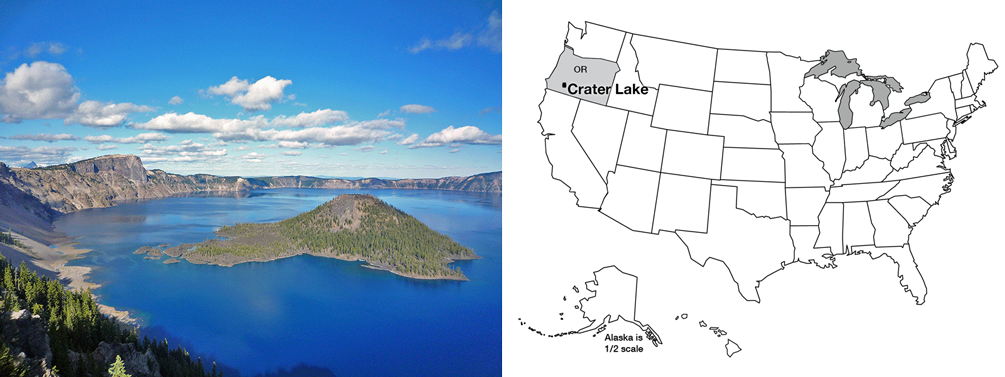Crater Lake

Right: Location of Crater Lake in Oregon
Right: R. B. Alley © Penn State is licensed under CC BY-NC-SA 4.0(link is external)
We will start with a little information on a truly wonderful National Park that you may wish to visit someday, and then move into important information on volcanic arcs and the “Ring of Fire”. Crater Lake, at 1932 feet (about 600 m) deep, is the deepest and probably the cleanest lake in the United States, and surely among the most beautiful. Crater Lake sits in a great volcanic crater or caldera, 5 miles (8 km) across, formed when Mt. Mazama experienced a cataclysmic eruption about 6600 years ago. That massive eruption laid down ash that is 200-300 feet thick (almost 100 m) on the flanks of the volcano; the ash forms a layer that has been preserved and is recognizable in the sediments in surrounding lakes, including in Yellowstone Lake almost 600 miles (1000 km) away, and a little of the ash has been found in Greenland ice cores.
The peak of the volcano had risen more than a mile above its mile-high base on the highlands of southwestern Oregon, but the great eruption removed about 4000 feet (1200 m) from the mountain’s height. About 16 cubic miles (40 cubic km) of rock were blown away. Glaciers had flowed down from the mountain peak; today, the glacial valleys can be followed upward until they disappear at the caldera rim. Although 50 feet (15 m) of snow falls in a typical year now, melting in the summer is more than sufficient to remove all this snow, so no glaciers exist. A tongue-in-cheek Christmas celebration on Aug. 25 substitutes for the snowbound December event.
After the great eruption, lava flows began building Wizard Island. If the water were removed from the lake, you could see that Wizard Island is roughly 0.5 mile (0.8 km) high. No permanent streams feed into the lake; the great rainfall and snowfall in the crater are balanced by evaporation, and by seepage through the rocks and eventually out the sides of the volcano as springs. With no streams supplying sediment, the lake is exceptionally clear and clean. Aquatic moss receives enough sunlight to grow 425 feet (130 m) below the water's surface. When trout were stocked in the lake, freshwater shrimp were stocked first because otherwise, biologists feared that the trout would have nothing to eat.
Take a Tour of Crater Lake National Park
Want to see more?
Visit the Crater Lake National Park(link is external) website. While you are not required to review this, you may find it interesting and possibly even helpful in preparing for the quiz!